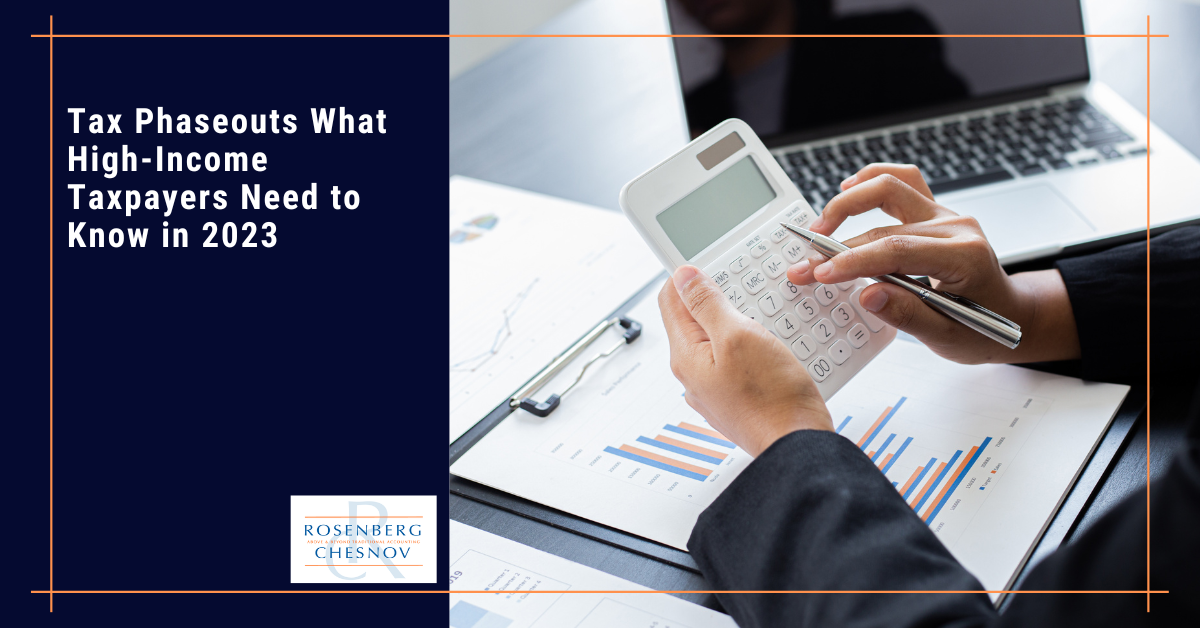What is a tax phaseout?
A tax phaseout is the decline in the value of certain tax advantages above a certain income level. The more money you make over specific thresholds, the lower the amount that some tax breaks will apply to you until, after a certain point, you get disqualified from using those tax breaks due to your high-income level.
To put it another way, some tax credits or deductions decrease as your income increases.
The IRS adjusts the phaseout levels yearly to account for inflation, meaning that the phaseout thresholds may change annually. It’s beneficial to be aware of how these changes impact your situation so that you can adjust your tax strategies accordingly.
This is where it gets more complicated: Various phaseouts work differently at different rates and therefore impact taxpayers differently. Some work at a constant rate over a specific range, while others reduce benefits by a set amount at specific incremental income thresholds. Some phaseouts reduce credits for all taxpayers over the thresholds, while others reduce deductions instead, meaning their impact in terms of dollar amount depends on the taxpayer’s marginal tax rate. (However, it’s also essential to understand the difference between tax phaseouts and marginal tax brackets — more on that in a moment.)
In short, think of this blog post as a general informational resource, not specific advice for your tax phaseout situation. For personalized guidance, always consult tax professionals (like us!).
What do high-income taxpayers need to understand about tax phaseouts?
Generally speaking, high-income taxpayers need to be aware of phaseouts that reduce tax credits, deductions, or other strategies for which they qualify within their given tax bracket. For example, let’s say you have a taxable income of $150,000 and qualify for a tax credit worth $2,500. If there is a phaseout in place, you may only be able to claim $1,500 of the credit, meaning you will only be able to take advantage of a reduced tax break. (Remember, these specific dollar amounts are just an arbitrary example to demonstrate the point — not necessarily a practical, real-world example!)
Lastly, it’s also essential to understand the difference between tax phaseouts and marginal tax brackets. While tax phaseouts reduce the number of deductions or credits for which you are eligible, marginal tax brackets determine the tax rate on your last dollar of income, as opposed to your first.
A marginal tax rate generally divides taxpayers into brackets, or ranges, based on taxable income — as your income rises, the last dollar you earn is taxed at the higher rate of the highest bracket for your total income. In contrast, the first dollar you earn is taxed at the rate for the lowest bracket. Meanwhile, the money in between is taxed at the rate for the bracket into which it falls.
The concepts of tax phaseouts and marginal tax brackets are similar in that they are both based on progressive taxation (taxation that increases with income). However, they are distinct — and understanding how they work together to determine your overall tax liability can help you maximize your tax advantages and minimize your bill.
What are examples of tax phaseouts?
As mentioned above, the exact structures, thresholds, and levels of various phaseouts can differ from one tax break to the next. However, some phaseouts apply to common tax breaks, such as the following…
- Alternative Minimum Tax Credit (AMT): Under the tax law, certain tax benefits can significantly reduce a taxpayer’s regular tax amount. The alternative minimum tax (AMT) applies to taxpayers with high economic income by limiting those benefits. It helps to ensure that those taxpayers pay at least a minimum amount of tax.
- Child Tax Credit: The Child Tax Credit helps families with qualifying children get a tax break. You can claim the credit even if you don’t typically file a tax return.
- Earned Income Tax Credit (EITC): The Earned Income Tax Credit (EITC) helps low- to moderate-income workers, and families get a tax break. If you qualify, you can use the credit to reduce the taxes you owe — and maybe increase your refund.
- Individual Retirement Accounts (IRAs): There are multiple types of IRAs, but broadly speaking, they are tax-advantaged personal savings plans for which contributions may or may not be tax-deductible (in a traditional IRA, they are, whereas, in a Roth IRA, they are not, but qualified distributions are tax-free).
Each of these tax breaks carries phaseouts that may apply to high-income taxpayers. However, this list is not inclusive — these are simply a few common examples.
To reiterate: the subject of tax phaseouts is far too complex to encapsulate in a single blog post, so if you have questions about your particular situation, it’s a good idea to consult a tax professional.
What tax changes will impact high-income taxpayers in 2023?
In a recent blog post, we discussed some changes taxpayers should be prepared for when filing their 2022 tax returns. These include the expiration of temporary pandemic-era benefits and stimulus and new regulations, many of which will remain in effect in the new year.
Skipping ahead to the 2023 tax-filing season, taxpayers can expect numerous inflation adjustments from the IRS to impact their tax brackets, deductions, and credits. The standard deduction, the additional standard deduction for taxpayers 65 and older, individual tax brackets for ordinary income and capital gains, and the maximum earned income credit will all jump in 2023.
Meanwhile, since individual federal tax brackets are automatically indexed for inflation, taxpayers whose income did not increase with inflation could find themselves with lower tax rates in 2023 than in 2022. Likewise, moderate-income retirees will pay taxes on a significant 8.7% increase in Social Security benefits.
Of course, in the 2023 tax filing season, as in the 2022 tax season, tax phaseouts will remain a vital concept for high-income taxpayers to understand.
By understanding tax phaseouts, high-income taxpayers can be better prepared to maximize their deductions and credits and minimize their tax liability in 2023.
Would you like some help?
If you are a client and would like to book a consultation, call us at +1 (212) 382-3939 or contact us here to set up a time.
If you aren’t a client, why not? We can take care of your accounting, bookkeeping, tax, and CFO needs so that you don’t have to worry about any of them. Interested? Contact us here to set up a no-obligation consultation.
Stay informed
Interested in receiving updates in your mailbox? Check out our newsletter, full of information you can use. It comes out once every two weeks, and you can register for it below.





